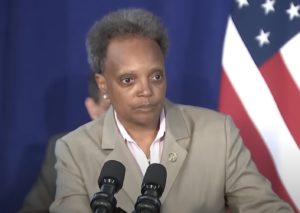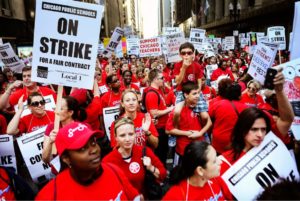Teachers unions spent big to get mandates and closures in Illinois
(Brett Rowland | The Center Square) – Teacher unions have used campaign spending, political organization and collective bargaining power to influence policy decisions during the…

(Brett Rowland | The Center Square) – Teacher unions have used campaign spending, political organization and collective bargaining power to influence policy decisions during the pandemic.
Democratic Gov. J.B. Pritzker and the state’s top two Democratic legislative leaders have received more than a combined $1.5 million from the state’s top teachers’ unions.
In contrast, the state’s top two Republican legislative leaders and former Republican Gov. Bruce Rauner have received less than $5,000 combined.
Democrats have controlled both chambers of the Illinois legislature since 2003.
The Chicago Teachers Union, the Illinois Education Association and the Illinois Federation of Teachers have used their collective influence to push for mask mandates, vaccine rules, remote learning, hiring practices, substitute teacher requirements and paid time off amid the COVID-19 pandemic. The Chicago Teachers Union went on strike in January, arguing it was unsafe to return to classrooms as COVID-19 cases increased. The teachers eventually reached an agreement with Chicago Public School leaders and Chicago Mayor Lori Lightfoot, but the dispute cost students and parents five days of school.
Pritzker vetoed House Bill 2778, which would have provided paid leave for school employees for COVID-19-related absences. The measure passed both legislative chambers last fall with a veto-proof majority. However, Pritzker worked with teachers to reach a negotiated compromise to provide such paid leave only for those who are fully vaccinated.
Teacher unions have also been vocal about mitigations in schools, at both the state and local level throughout Illinois, including mask mandates and vaccine requirements. They were highly critical of district judge’s recent decision ruling Pritzker’s school mask mandate “null and void,” calling it a “threat to keeping Illinois schools open for in-person learning.”
Illinois lawmakers have largely taken a hands-off approach during the pandemic, letting Pritzker guide the state’s pandemic response through executive orders, including rules that require educators and many state employees to get vaccinated against COVID-19 and mandating mask use in Illinois schools.
Ted Dabrowski, president of Wirepoints, said teacher unions used their influence throughout the pandemic.
“Teacher unions have always had a scratch-my-back relationship with politicians and we’ve seen that playing out in the COVID era,” he said. “They want more remote learning and mitigations.”
Dabrowski said the influence of teacher unions goes beyond political donations.
“They have very strong collective bargaining power and they are using that power,” he said. “The unions have oversized power over parent’s rights.”
The Illinois Education Association, which represents more than 135,000 educators, did not respond to a request for comment on its influence.
Teacher unions are among the top donors to some of the state’s most powerful Democrats, including Gov. J.B. Pritzker, Senate President Don Harmon, D-Oak Park; and House Speaker Emanuel “Chris” Welch, D-Chicago. In the most recent election cycle, 94% of campaign donations from teacher unions went to Democrats.
Pritzker, who Forbes estimates has a net worth of $3.6 billion, has largely funded his own campaigns. Pritzker has given his campaign, JB for Governor, a total of $303,550,034, according to campaign finance records from Illinois Sunshine. The Illinois Education Association has given JB for Governor a total of $111,911, making the organization among the campaign’s top five donors of all time behind the Democratic Party of Illinois ($1,546,601.52), cousin Matthew Pritzker ($250,000) and investor James A. Star ($153,220).
Teacher unions have spent more donating to Harmon and Welch over the years. Friends of Don Harmon for State Senate has taken in a total of $434,682 from Illinois Federation of Teachers COPE and $231,439.51 from I.P.A.C.E., the Illinois Political Action Committee for Education, which works to elect candidates for the Illinois Education Association. Harmon has $12,409,142.62 cash on hand, according to Illinois Sunshine. A spokesperson for Harmon did not respond to a request for comment.
Welch’s campaign, The People for Emanuel “Chris” Welch, has $7,708,420.84 cash on hand. Top donors to the candidate committee include I.P.A.C.E (for a total of $333,800), Illinois Federation of Teachers COPE ($318,940) and Chicago Teachers Union PAC ($95,750). A spokesperson for Welch did not respond to a request for comment.
The state’s most powerful Republicans got much smaller amounts. IPACE has donated a total of $500 to Elect Dan McConchie, the candidate committee for Senate Minority Leader Dan McConchie, R-Hawthorn Woods, according to Illinois Sunshine. IPACE has donated a total of $750 to Citizens for Durkin, the candidate committee for House Republican Leader Jim Durkin, R-Western Springs. Illinois Federation of Teachers COPE gave Citizens for Durkin $3,500, with the most recent contribution in 2019. Like Pritzker, Rauner also primarily funded his own campaigns and didn’t get donations from either group.
In recent election cycles, Illinois teacher unions have given nearly all of their political contributions to Democrats.
Kent Redfield, emeritus professor of political science at the University of Illinois Springfield, said that is partly because Democrats have more incumbents than Republicans and control both the Illinois House and Illinois Senate. The difference has been stark.
During the 2019-20 election cycle, teacher unions contributed $8.6 million to benefit candidate, legislative caucus and party committees in legislative elections in 2020. Of that $8.6 million, 94% (or $8.05 million) went to Democrats, according to Redfield’s analysis of campaign spending. Contributions from teacher unions made up only part of the $58.3 million that labor groups spent during the cycle. Labor groups have spent more than any other donors in recent years, including business and professional groups, policy organizations, law groups and lobbyists and government affairs groups.

Courtesy of Kent Redfield
Redfield said that teacher unions tend to stick to education issues.
“Within their sphere, they dominate education committees in terms of policy and they dominate the substantive conversation around education,” he said.
Redfield also said teacher unions have multiple layers of influence.
“Teachers are significant contributors and really effective from a lobbying perspective,” he said. “That’s a big advantage. Because they have collective bargaining and the right to strike, they are much stronger. They are strong locally and strong statewide.”



